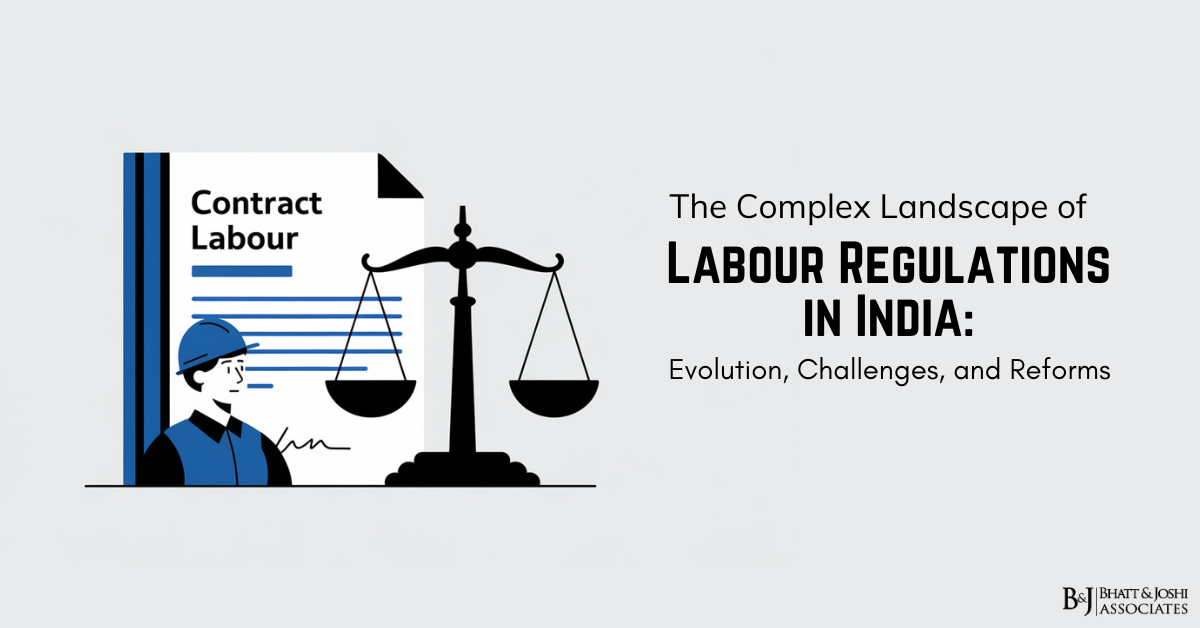Introduction
Contract labour has become an integral part of India’s economic framework, particularly in the wake of globalization and the liberalization of the economy. As businesses strive for greater flexibility and cost-efficiency, the use of contract labour has surged, leading to significant implications for workers’ rights, employment conditions, and industrial relations. The , is the primary legislation governing the employment of contract labour in India. This Act was enacted with the dual objectives of regulating the conditions of work for contract labour and, where necessary, abolishing the practice altogether in certain sectors to prevent exploitation. Over the years, however, the implementation of the Act has been fraught with challenges, particularly in light of the changing economic landscape, the rise of the gig economy, and the increasing informalization of the workforce. This article explores the evolution of contract labour regulations in India, the key provisions of the Contract Labour Act, the challenges in its implementation, and the need for reform to address contemporary labour market dynamics.
Historical Context and Legislative Background
The concept of contract labour is not new to India; it has existed in various forms throughout the country’s economic history. However, the exploitation and poor working conditions associated with contract labour became particularly pronounced during the colonial period, when the British government encouraged the use of cheap and flexible labour for the development of infrastructure and industries. The lack of legal protections for contract workers led to widespread abuse, prompting demands for regulation. The post-independence era saw the Indian government grappling with the challenge of balancing the needs of a rapidly industrializing economy with the imperative of protecting workers’ rights. The Contract Labour (Regulation and Abolition) Act, 1970, was enacted in response to growing concerns about the exploitation of contract workers. The Act sought to regulate the employment of contract labour, improve their working conditions, and provide for the abolition of contract labour in certain circumstances where it was deemed to be exploitative. The enactment of the Contract Labour Act was a significant step in India’s labour law framework, as it recognized the distinct challenges faced by contract workers and sought to address them through a comprehensive legal framework. However, the Act also reflected the complexities of regulating a diverse and dynamic labour market, where contract labour played a crucial role in many industries.
Key Provisions and Objectives of the Contract Labour Act in India
The Contract Labour (Regulation and Abolition) Act, 1970, is designed to regulate the employment of contract labour in establishments and to provide for the abolition of contract labour in certain cases. The Act applies to every establishment and contractor employing 20 or more workers. It mandates the registration of establishments employing contract labour and the licensing of contractors who supply contract labour.
One of the key objectives of the Act is to ensure that contract workers are not subjected to exploitation and that they receive fair wages and decent working conditions. To this end, the Act lays down several important provisions, including:
- Regulation of Employment: The Act requires establishments that employ contract labour to be registered with the appropriate government authorities. Similarly, contractors supplying contract labour must obtain a license. This ensures that the employment of contract labour is monitored and regulated.
- Wages and Working Conditions: The Act mandates that contract workers must be paid wages that are on par with those of regular workers performing similar work. It also provides for the regulation of working conditions, including hours of work, rest intervals, and the provision of canteens, restrooms, and other amenities.
- Abolition of Contract Labour: The Act empowers the government to prohibit the employment of contract labour in certain circumstances where it is found to be exploitative. This includes situations where the work is perennial in nature, is essential to the establishment, or where the use of contract labour is deemed to be against the interests of the workers.
- Welfare and Social Security: The Act includes provisions for the welfare of contract workers, such as the payment of gratuity, provident fund contributions, and compensation for injury or illness. It also mandates the provision of health and safety measures to protect contract workers from workplace hazards.
- Dispute Resolution: The Act provides for the resolution of disputes between contract workers and their employers through conciliation, arbitration, and adjudication. This ensures that contract workers have access to legal recourse in case of disputes.
Challenges in Implementing the Contract Labour Act in India
Despite its comprehensive framework, the implementation of the Contract Labour Act has faced several challenges. One of the primary challenges is the widespread non-compliance with the Act’s provisions, particularly in the informal sector. Many employers continue to employ contract labour without adhering to the registration and licensing requirements, resulting in a lack of regulation and protection for contract workers. Another significant challenge is the disparity in wages and working conditions between contract workers and regular employees. Despite the legal mandate for parity in wages, contract workers often receive lower wages and are subjected to poorer working conditions compared to their regular counterparts. This is exacerbated by the lack of effective enforcement mechanisms, as labour inspectors are often under-resourced and overburdened, limiting their ability to monitor compliance effectively. The process of abolishing contract labour in certain sectors has also been fraught with challenges. The criteria for determining when contract labour should be abolished are often vague and subject to interpretation, leading to inconsistencies in the application of the law. Moreover, the abolition of contract labour in certain sectors has sometimes resulted in job losses, as employers have opted to automate or outsource work rather than employ regular workers. The rise of the gig economy and the increasing use of temporary and flexible work arrangements have further complicated the implementation of the Contract Labour Act. The traditional employer-employee relationship is being replaced by more fluid and decentralized forms of work, where workers are often classified as independent contractors rather than employees. This has led to a situation where many workers are excluded from the protections of the Contract Labour Act, as they do not fit within the traditional definition of contract labour.
The Role of the Judiciary in Interpreting the Contract Labour Act
The judiciary has played a crucial role in interpreting the provisions of the Contract Labour Act and in shaping its implementation. Several landmark judgments by the Supreme Court and High Courts have clarified the scope and application of the Act, particularly in cases where the status of contract workers or the validity of contract labour arrangements has been disputed. One of the most significant judicial interventions in this area was the Supreme Court’s ruling in the case of Steel Authority of India Ltd. v. National Union Waterfront Workers (2001). In this case, the Court held that the mere abolition of contract labour by the government does not automatically result in the absorption of contract workers as regular employees. The Court emphasized that the absorption of contract workers must be based on the specific terms and conditions of the contract and the nature of the work being performed. In another important case, Hindustan Steel Works Construction Ltd. v. Commissioner of Labour (1996), the Supreme Court ruled that the engagement of contract labour for work that is perennial in nature and forms an integral part of the establishment’s operations is contrary to the provisions of the Act. The Court held that in such cases, the employment of contract labour should be abolished, and the workers should be absorbed as regular employees. The judiciary has also played a role in addressing the issue of parity in wages and working conditions between contract workers and regular employees. In the case of State of Haryana v. Piara Singh (1992), the Supreme Court held that contract workers performing the same work as regular employees are entitled to the same wages and working conditions. This judgment reinforced the principle of equal pay for equal work and has been instrumental in improving the wages and working conditions of contract workers.
The Impact of Economic Liberalization and Globalization
The economic liberalization and globalization of the Indian economy in the early 1990s brought significant changes to the labour market, with profound implications for the regulation of contract labour. The shift towards a market-oriented economy led to the growth of contract labour as businesses sought greater flexibility in their workforce to remain competitive in the global market. This has led to an increase in the use of contract labour across various sectors, including manufacturing, construction, services, and information technology. However, the rise of contract labour has also raised concerns about the erosion of workers’ rights and the weakening of labour standards. The focus on cost-cutting and flexibility has often resulted in the exploitation of contract workers, who are subjected to poor working conditions, low wages, and job insecurity. The use of contract labour has also led to the fragmentation of the workforce, with contract workers being treated as a separate and inferior class of workers compared to regular employees. Globalization has also created new challenges for the enforcement of the Contract Labour Act. The integration of Indian labour markets into global supply chains has increased the complexity of labour arrangements, with multiple layers of contractors and subcontractors involved in the supply chain. This has made it difficult to regulate and monitor the employment of contract labour, as the lines of responsibility and accountability are often blurred. At the same time, globalization has also created opportunities for improving the regulation of contract labour. The growing emphasis on corporate social responsibility and the pressure from international buyers for compliance with labour standards have led to the adoption of voluntary standards and certification schemes that promote the fair treatment of contract workers. These initiatives have the potential to complement the legal framework of the Contract Labour Act and enhance the protection of contract workers.
The Role of Trade Unions and Collective Bargaining
Trade unions have played a critical role in advocating for the rights of contract workers and in challenging the misuse of contract labour arrangements. In many cases, trade unions have successfully negotiated for the absorption of contract workers as regular employees and have used collective bargaining to secure better wages and working conditions for contract workers. However, the effectiveness of trade unions in representing contract workers has been limited by several factors. The decline in union density, particularly in the organized sector, has weakened the bargaining power of trade unions and their ability to influence labour policy. The fragmentation of the workforce, with the rise of temporary and flexible work arrangements, has also made it difficult for trade unions to organize contract workers and represent their interests effectively. The Contract Labour Act itself poses challenges to the unionization of contract workers. The temporary and precarious nature of contract work often discourages workers from joining trade unions, as they fear retaliation from employers or the loss of their jobs. Moreover, the legal framework of the Act does not explicitly provide for the recognition of trade unions representing contract workers, making it difficult for unions to engage in collective bargaining on behalf of contract workers. Despite these challenges, trade unions continue to play a vital role in advocating for the rights of contract workers. Through litigation, public campaigns, and negotiations, trade unions have been instrumental in challenging the exploitation of contract workers and in pushing for reforms to the Contract Labour Act.
The Need for Reform and Future Directions
The Contract Labour (Regulation and Abolition) Act, 1970, is a critical piece of legislation that has played an important role in regulating the employment of contract labour in India. However, the Act is not without its shortcomings, and there is a growing recognition that it needs to be reformed to address the challenges of the contemporary labour market. One of the key areas for reform is the need to expand the coverage of the Act to include workers in the informal sector and other non-traditional forms of employment. The rise of the gig economy and the increasing use of temporary and flexible work arrangements have created new forms of contract labour that are not adequately covered by the current legal framework. There is a need for a more inclusive and flexible legal framework that can adapt to the changing nature of work and provide protection to all workers, regardless of their employment status. Another area for reform is the need to strengthen the enforcement mechanisms under the Act. This could involve increasing the number of labour inspectors and providing them with the necessary resources and authority to enforce the law effectively. The use of technology, such as digital platforms for registering contract workers and monitoring compliance, could also be explored to improve transparency and accountability in the employment of contract labour.
There is also a need to address the issue of parity in wages and working conditions between contract workers and regular employees. The principle of equal pay for equal work should be firmly entrenched in the legal framework, and mechanisms should be put in place to ensure that contract workers receive the same wages and working conditions as their regular counterparts. This could involve the introduction of minimum wage laws that apply specifically to contract workers and the strengthening of collective bargaining rights for contract workers. Finally, there is a need for greater social dialogue and consultation in the formulation of labour policies. The voices of contract workers, trade unions, and other stakeholders should be heard in the policy-making process, ensuring that labour policies reflect the needs and interests of all workers. The principle of tripartism, which involves the government, employers, and workers in the formulation of labour policies, should be strengthened to promote consensus-building and social harmony.
Conclusion
The Contract Labour (Regulation and Abolition) Act, 1970, is a landmark piece of legislation that has played a crucial role in regulating the employment of contract labour in India. It represents a commitment to protecting the rights of contract workers and ensuring that they are not subjected to exploitation and poor working conditions. However, the Act faces significant challenges in its implementation, particularly in light of the changing dynamics of the labour market. The rise of the informal sector, the gig economy, and the increasing use of temporary and flexible work arrangements have created new forms of contract labour that are not adequately covered by the current legal framework. There is a need for reform to ensure that the Act remains relevant and effective in protecting the rights of all workers. By addressing these challenges and building on the strengths of the Act, India can move closer to realizing the vision of a fair and just labour market where all workers, including contract workers, are treated with dignity and respect. The Contract Labour Act is not just a legal document; it is a promise to the millions of contract workers in India that their rights will be respected, and their livelihoods will be secured. As the country moves forward, it is essential to ensure that this promise is fulfilled, and that contract workers are empowered to live with dignity and economic security.














